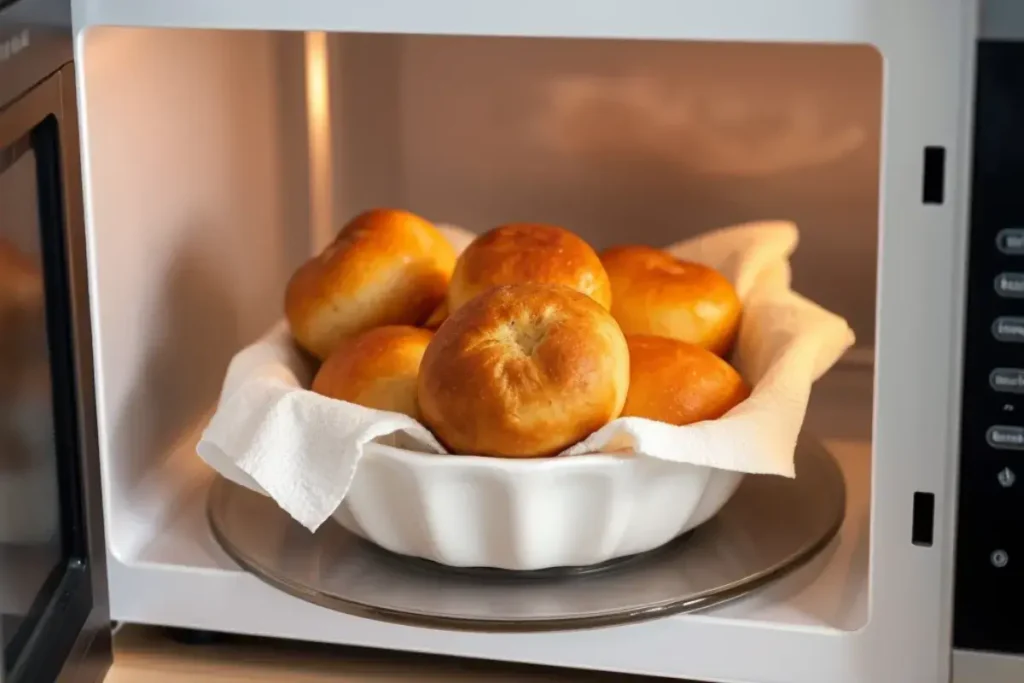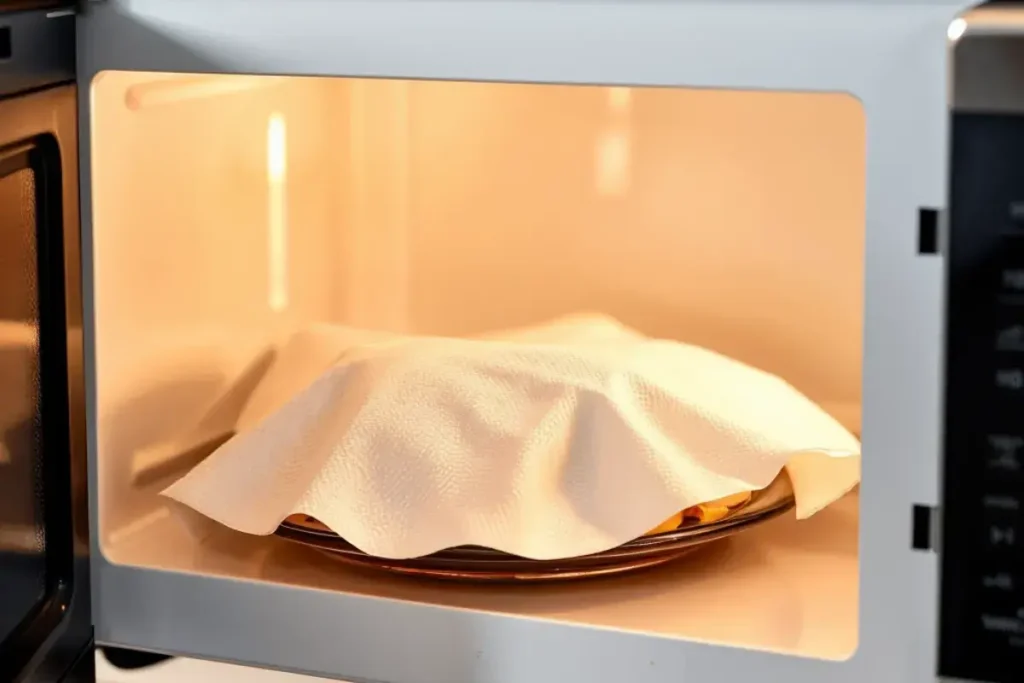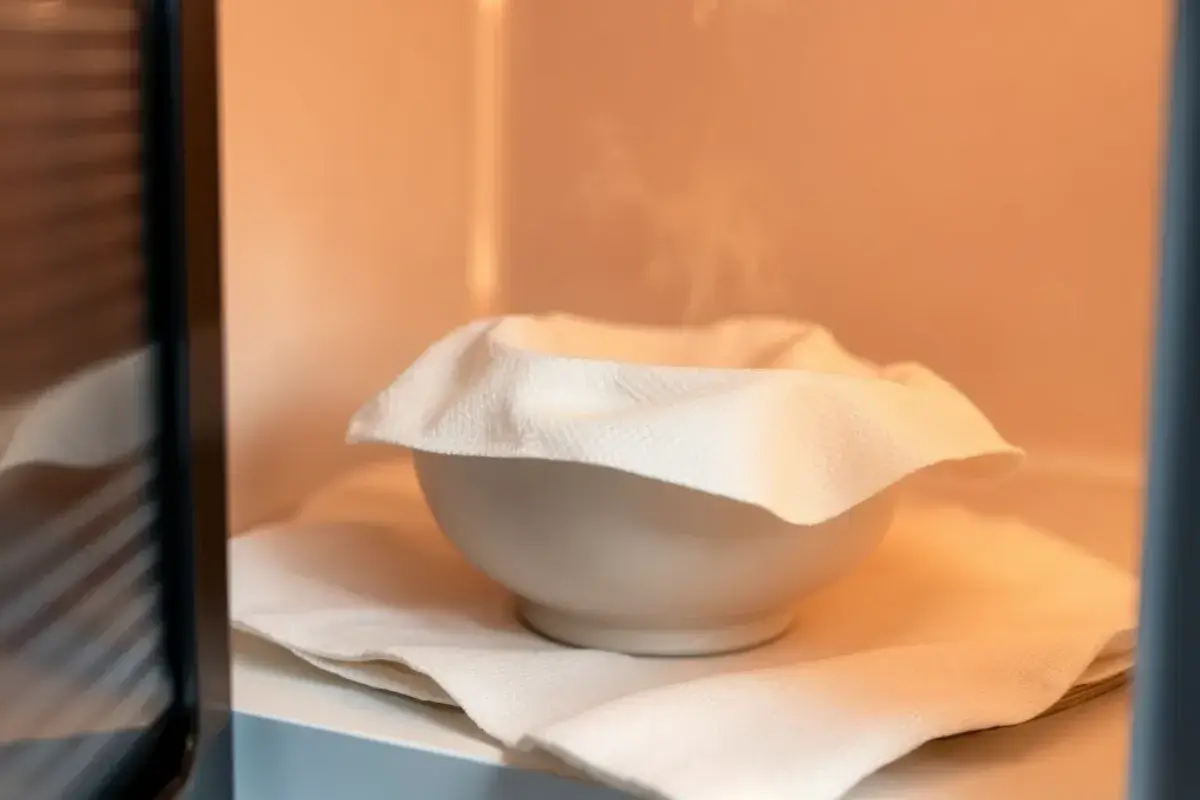If you’ve ever wondered whether microwaving with a wet paper towel works, you’re not alone. This simple kitchen hack is popular for reheating food while keeping it moist and delicious. With microwaves being a staple in most kitchens, finding ways to enhance their efficiency is valuable. But does adding a wet paper towel really make a difference? In this article, we’ll explore the science behind this technique, its practical uses, and whether it’s worth trying.
How Microwaving Works
To understand why a wet paper towel might help, it’s important to know how microwaves work. Microwaves cook food by emitting electromagnetic waves that cause water molecules to vibrate. This vibration generates heat, which then cooks or reheats the food. The process is quick because microwaves penetrate the food, heating it from the inside out.
This method is especially effective for foods with high moisture content. The water molecules absorb the microwave energy, creating steam that aids in cooking. For more on how microwaves work and their nutritional effects, check out this resource on microwave cooking basics.
Science Behind Using Wet Paper Towels in the Microwave
So, how does a wet paper towel fit into this process? The key is moisture. Adding a damp paper towel on top of your food provides an extra source of moisture. This creates a steaming effect, which helps heat the food more evenly and prevents it from drying out. The paper towel traps steam close to the food, reducing hot spots—those annoying areas where food overheats or burns while other parts remain cold.
A wet paper towel is especially useful when reheating food like pizza, bread, or tortillas, which dry out quickly in the microwave. The moisture maintains the food’s texture, making it more enjoyable to eat. For safe and effective use of materials like paper towels in the microwave, see this guide on safe microwave practices.
Common Uses of Wet Paper Towels in Microwaving
Using a wet paper towel in the microwave isn’t just a gimmick—it’s practical for various cooking and reheating tasks. Here are some common scenarios where this method can make a significant difference:
- Reheating Leftovers: Leftovers like pasta, rice, or meat often dry out when reheated. Covering them with a wet paper towel helps retain their original moisture and texture.
- Cooking Vegetables: Fresh vegetables can be quickly steamed in the microwave by covering them with a damp paper towel. This helps them cook evenly while preserving their nutrients. For a specific guide on how to cook potatoes using this method, check out our detailed microwave baked potato recipe.
- Warming Bread and Tortillas: Bread and tortillas tend to get hard and chewy when microwaved. Wrapping them in a wet paper towel keeps them soft and pliable.
Potential Benefits of Microwaving with a Wet Paper Towel

Now that we’ve covered the basics, let’s dive into the specific benefits:
- Retaining Moisture in Food: One of the main reasons people use a wet paper towel is to keep food from drying out. The moisture from the towel rehydrates the food, preserving its texture and flavor.
- Even Cooking and Heating: Adding moisture helps distribute heat more evenly. This is crucial when reheating dishes like casseroles or baked goods. It reduces the chances of cold spots and ensures that the food is heated through without becoming too dry.
- Food Safety: Using a wet paper towel can also make your microwave experience safer. When heating food that contains water, steam builds up and creates pressure pockets. The moisture from the towel helps control this steam, preventing sudden bursts or explosions that could make a mess or even damage your microwave.
In summary, microwaving with a wet paper towel is a simple change that can lead to big improvements in the quality of your reheated or cooked food. Whether you’re trying to retain moisture, ensure even heating, or avoid microwave mishaps, this technique offers several practical benefits worth exploring.
Step-by-Step Guide: How to Use a Wet Paper Towel in the Microwave
Microwaving with a wet paper towel is a straightforward process, but doing it correctly ensures you get the best results. Here’s a simple step-by-step guide:
- Step 1: Preparing the Paper Towel
Start by dampening a paper towel with water. You want it to be wet but not dripping. Squeeze out any excess water so that the towel is moist but not overly saturated. - Step 2: Covering the Food
Place the wet paper towel over the food you want to reheat or cook. For items like bread or tortillas, you might want to wrap them entirely. For dishes like pasta or rice, simply lay the towel on top. For an example of how to use this method with potatoes, see our guide on microwaving potatoes with a wet paper towel. - Step 3: Microwave Settings
Adjust the microwave settings based on the type of food. Lower power settings (around 50-70%) are often better for even heating. This prevents the food from drying out or overheating. Start with a shorter cooking time and check the food, adding more time if needed.
This method is ideal for reheating leftovers or cooking quick meals. It’s simple but effective in retaining moisture and ensuring even heating.
Common Mistakes to Avoid
While using a wet paper towel in the microwave is easy, there are a few common mistakes that can reduce its effectiveness:
- Over-saturating the Paper Towel: If the paper towel is too wet, it can cause sogginess or excess steam, which might lead to uneven heating. Always wring out excess water before use.
- Using a Dry or Insufficiently Wet Towel: On the flip side, using a towel that’s too dry won’t provide the needed moisture, and your food may still dry out. Ensure the towel is damp enough to generate steam.
- Placing the Paper Towel Too Close to the Food Surface: If the towel is directly touching the food, it might stick or become part of the dish, especially if the food has a high moisture content. Leave a little space to allow steam to circulate.
Risks and Concerns: Is It Safe?
Using a wet paper towel in the microwave is generally safe, but there are a few potential risks to be aware of:
- Fire Hazard: While rare, overheating a paper towel could cause it to catch fire, especially if the towel is too dry. Always ensure the towel is sufficiently damp before microwaving and avoid leaving it in the microwave for too long.
- Chemical Concerns: Some paper towels are bleached or contain other chemicals. When heated, these chemicals could potentially leach into your food. To minimize this risk, use unbleached, chemical-free paper towels.
- Microwave Damage: Prolonged use of this method shouldn’t harm your microwave. However, repeated exposure to high levels of moisture could, over time, lead to some wear on the interior, especially if steam condenses and pools inside.
Comparing Wet Paper Towels to Other Microwave Hacks

Microwaving with a wet paper towel isn’t the only hack out there. Here’s how it compares to some other popular methods:
- Microwave Covers: These are designed to trap steam and prevent food from splattering. While they’re convenient, they don’t add moisture like a wet paper towel. If you’re trying to keep food moist, the paper towel might be more effective.
- Plastic Wrap or Containers: Plastic wrap can also trap steam, but it’s not as eco-friendly, and some people are concerned about chemicals in plastic when heated. Using a damp paper towel is a safer, more environmentally friendly option.
- Damp Cloths: Some people use damp cloths instead of paper towels. These can be effective, but they require more cleaning and maintenance. Plus, not all cloths are microwave-safe, so you need to be cautious.
Environmental Considerations
While using a wet paper towel in the microwave is convenient, it’s important to consider the environmental impact. Paper towels are disposable and contribute to waste. If you’re microwaving frequently, this waste can add up.
- Paper Towel Waste: Single-use paper towels are not sustainable. Every time you use one, it adds to the amount of trash we produce.
- Reusable Alternatives: Consider using reusable microwave-safe covers or cloths. These alternatives can offer the same benefits without the environmental cost. A damp kitchen towel, for example, can be just as effective and is washable, reducing waste.
Expert Opinions and Studies
Chefs and food scientists often recommend using a wet paper towel in the microwave, particularly for reheating delicate foods. The moisture helps maintain the food’s texture, which is essential for dishes like bread or pastries.
- Chef Recommendations: Many chefs suggest this method for reheating to avoid drying out food. They often use it when microwave space or time is limited.
- Scientific Research: Studies on microwave cooking have found that moisture plays a crucial role in even heating. This supports the idea that adding moisture, whether through a wet paper towel or other methods, can improve the quality of microwaved food.
User Experiences and Testimonials
Many people who use this method regularly report positive experiences. Home cooks appreciate how easy it is to keep food moist without extra equipment. Online forums are filled with testimonials praising the effectiveness of a wet paper towel for reheating.
- Positive Experiences: Users frequently note that this technique works particularly well for bread, pasta, and other foods that tend to dry out. They often share tips on how to adjust the technique for different foods.
- Negative Experiences: A few users have reported issues with overheating or burning the paper towel, but these cases are rare. Most problems can be avoided by ensuring the towel is adequately wet and not microwaving it for too long.
Conclusion: Does Microwaving with a Wet Paper Towel Really Work?
After exploring the science, practical uses, and expert opinions, it’s clear that microwaving with a wet paper towel is an effective technique. It helps retain moisture, ensures even heating, and can prevent common microwave mishaps. While there are some risks, such as potential fire hazards or chemical concerns, these are minimal and easily managed with proper precautions. Whether you’re reheating leftovers or cooking quick meals, this method offers a simple and effective way to improve your microwave cooking experience. So, go ahead—give it a try and see the difference it can make in your kitchen.
FAQs
- Can I microwave all types of food with a wet paper towel?
Yes, but be cautious with foods that are already very moist. Adding too much moisture can make them soggy. - Is there a risk of chemicals leaching from the paper towel into my food?
It’s possible if the paper towel is bleached or treated with chemicals. Use unbleached, chemical-free paper towels to minimize this risk. - How wet should the paper towel be?
The towel should be damp but not dripping. Wring out excess water to prevent sogginess or excess steam. - Can I use this method to microwave frozen foods?
Yes, but adjust the cooking time and check the food regularly. The wet paper towel can help prevent the food from drying out as it defrosts. - Is it safe to microwave paper towels every day?
Generally, yes. Just ensure the towel is wet enough to avoid any risk of fire, and don’t overheat it.

